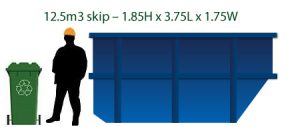Skip Bin Sizing Basics
Selecting the appropriate skip bin size is crucial for effective waste management. Whether you’re undertaking a home renovation, clearing out your garden, or managing waste at a construction site, understanding skip bin sizing can streamline the process and ensure you choose the right bin for your needs. This guide covers the basics of skip bin sizing to help you make informed decisions and manage waste efficiently.
Why Skip Bin Size Matters
The size of the skip bin you choose affects several factors, including the cost, the efficiency of waste disposal, and the amount of trips needed to transport waste. Choosing the correct size prevents overfilling or underutilization, saving you time and money.
Cost Implications
Skip bins are often priced based on their size. Opting for a bin that’s too large can lead to unnecessary costs, while a bin that’s too small may require additional hires. Selecting the right size helps manage your budget effectively.
Efficiency of Waste Disposal
Efficient waste disposal relies on proper skip bin sizing. A well-chosen bin minimizes the need for multiple trips, reduces the risk of overloading, and ensures that waste is disposed of in a timely manner.
Common Skip Bin Sizes
Skip bins come in various sizes to accommodate different types and volumes of waste. Here are some common sizes and their typical applications:
2m³ Skip Bin
The 2m³ skip bin is suitable for small clean-ups, such as garden waste or minor household decluttering. It is ideal for small DIY projects or home renovations.
4m³ Skip Bin
A 4m³ skip bin is appropriate for small to medium-sized projects, such as kitchen or bathroom renovations. It can handle a moderate amount of waste and is commonly used for household clean-ups.
6m³ Skip Bin
With a 6m³ capacity, this skip bin is designed for medium-sized renovation projects, garden clearances, and small construction sites. It offers ample space for a variety of waste types.

8m³ Skip Bin
The 8m³ skip bin is well-suited for larger home renovations, commercial clean-ups, and medium-sized construction works. It provides extra capacity for substantial amounts of waste.
10m³ Skip Bin and Larger
For extensive projects, such as major home renovations, large construction sites, or industrial waste, a 10m³ skip bin or larger is recommended. These bins are designed to handle significant volumes of waste efficiently.
How to Determine the Right Skip Bin Size
Choosing the correct skip bin size involves evaluating several factors. Here’s a step-by-step guide to help you determine the right size for your project:
Assess the Type of Waste
The type of waste you need to dispose of influences the size of the skip bin required. Different types of waste, such as green waste, construction debris, or general household rubbish, may require different bin sizes.
Estimate the Volume of Waste
Accurately estimating the volume of waste is key. Measure the dimensions of your waste pile (length, width, height) and calculate the volume in cubic meters. This will give you an idea of the bin size needed.
Consider Project Duration
For short-term projects, a smaller bin may suffice. However, for long-term projects, you might need a larger bin or multiple bins to manage the accumulating waste effectively.
Tips for Optimizing Skip Bin Use
Maximizing the efficiency of your skip bin can save you time and money. Here are some tips to optimize skip bin use:
Sort and Separate Waste
Separate your waste into categories such as recyclables, general waste, and hazardous materials. This not only helps in proper disposal but also ensures that the skip bin is used effectively.
Disassemble Large Items
Breaking down large items, such as furniture, can help you utilize the skip bin space more efficiently. Disassembled items take up less room and allow for better organization within the bin.
Fill the Bin Evenly
Distribute the waste evenly in the skip bin to maximize space and prevent overloading. Avoid creating piles that may cause the bin to become unstable or exceed its capacity.
Legal and Safety Considerations
Adhering to legal and safety guidelines is essential when using skip bins. Here are some important considerations:
Permits and Regulations
Check with local authorities or your skip bin provider to determine if a permit is required for placing the bin. Some areas have regulations regarding skip bin placement and usage.
Prohibited Items
Certain items, such as hazardous materials, asbestos, and chemicals, are prohibited from being placed in skip bins. Ensure you follow the guidelines provided by your skip bin provider to avoid penalties and safety issues.
Safe Loading Practices
Do not overfill the skip bin beyond its rim. Overloading can create safety hazards and result in additional charges. Follow the recommended guidelines for safe loading to ensure proper disposal.
Conclusion
Understanding skip bin sizing basics is crucial for effective waste management. By selecting the appropriate size based on your project needs and following best practices, you can ensure efficient and cost-effective waste disposal. For more guidance or to hire a skip bin, consult with your local skip bin provider and get expert advice tailored to your specific requirements.
